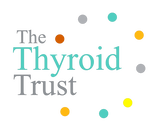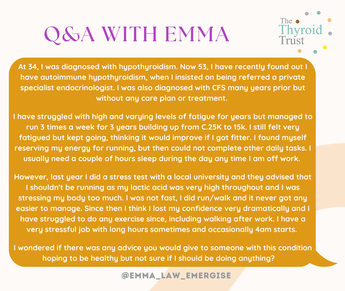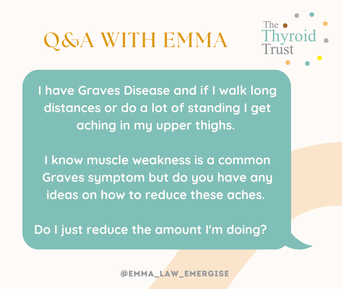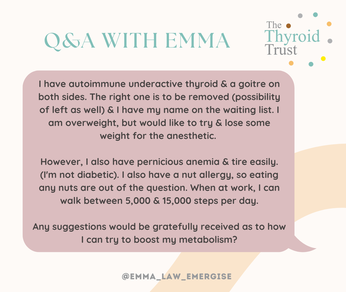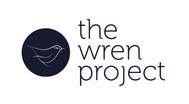Please contact us, if you have a question for Emma.
I read that carb cycling is better for weight loss if you have hypothyroidism (treated with Levothyroxine) I’ve not managed to find good information on this. Can you share your thoughts?
Thank you for your question regarding carb cycling and hypothyroidism. There’s quite a bit of info about this out on the interweb, but what we can rely on and what borders on fiction is quite difficult to fathom.
Carb cycling can be beneficial to thyroid patients, as it can be a safe and effective way to lose fat and boost energy levels. Controlling the carb intake takes focus, planning, monitoring and dedication, but it can be a good way to minimise the symptoms of insulin resistance and maintain a stable blood sugar level which in turn can increase your sensitivity to the thyroid hormones.
Now that all sounds fab right? – but there is a downside which has to be considered before we embark on a carb cycling lifestyle. Hypothyroid patients must be especially careful as drastically reducing carbs for extended periods can potentially affect thyroid function and lead to further issues and complications. The thyroid gland requires carb-derived energy to produce and regulate thyroid hormones properly. The thing we should be concerned about here is that extended periods of reduced carb intake can inhibit the conversion of T4 (thyroxine) into the active thyroid hormone triiodothyronine (T3). And as I have mentioned previously, severely dropping your carb intake can trigger a ‘starvation mode’ response in the body, leading to the storage of fat on to areas such as stomach, hips and thighs.
It all boils down to the fact that there is no clear agreement on whether carb cycling is safe for people with hypothyroidism. Some think that it is beneficial, others say to proceed with caution. So if you are keen to try it I would suggest that you speak with your GP or healthcare professional to ensure that your levels are all good, and then start small. Drop the carbs a little on days where you are not exercising and monitor your results carefully. If you are having an active day, then you must eat enough carbs as your body will require more fuel. Any kind of calorie deficit should be calculated for you personally according to your height, weight and activity levels, so please make sure you have this done before you embark on any changes. A good personal trainer should be able to assist with these calculations.
The key is to balance the carb cycling – those of us with hypothyroidism need to prioritise our health, monitor our symptoms, and ensure that we are working within the parameters of our own bodies. So, track the calories, track the carbs and other macros, and make a note of your body’s response, both physically and emotionally. Being cautious will allow you to enjoy the benefits of carb cycling, whilst supporting your optimal thyroid function and overall well-being.
Good luck!
Emma
Hi, I’m feeling confused with conflicting advice regarding diet/nutrition to lose weight. I’ve gained 3 stone since surgically induced menopause and Graves medication. I’m 53 the majority of things popping upon social media etc is to do intermittent fasting.
The conflicting advice out there is confusing and I don’t know what to do for the best. For all of this year so far I have been trying to lose this gained weight to no avail and this along with the physical facial changes with TED is causing a depression.
The conflicting advice out there is confusing and I don’t know what to do for the best. For all of this year so far I have been trying to lose this gained weight to no avail and this along with the physical facial changes with TED is causing a depression.
Thank you for your email. This is a great big question - let’s unpick it bit by bit.
As you know, female weight gain is one of the huge number of symptoms of the menopause, caused by a lack of oestrogen in the body. This drop in hormones can cause many issues; the biggest one being the laying down of fat tissue on the hips and waist. However, there’s far more going on here for you than just the menopause symptoms because the TED and Grave’s Disease also play a huge part in what you are going through.
In Thyroid Eye Disease, the immune cells that attack the thyroid gland (to cause your Graves’ disease) also attack what we call adipose tissue (body fat) as well as the fibroblast tissues around the eyes. The body responds and suddenly we feel totally out of control and there is a confusing amount of diet and weight management information, not all of it accurate, to try to wade through.
Now Wendy you don’t mention how long it’s taken for the weight to go on, but a gain of three stone means that unless you were underweight before the surgery, a regular ‘eat well move more’ approach should work very effectively for you. However, you mention that you’ve tried dieting and it’s not worked. I know social media is full of ideas such as intermittent fasting, Zoe blood calculators, ketone powders and slimming clubs – and therein lies the problem. Nothing is a ‘one size fits all’ – and all of those probably work for other people individually, but not everyone. You don’t mention what sort of diet you’ve done, whether it is a slimming club, or app, but I think we must find the right path for you personally, rather than what other people might find successful.
The first thing I would like you to do is check that all your medication is correct without contraindications or clashes – does anything that you have been prescribed inhibit any other meds, slow your metabolism, affect your thyroid function etc. Are you suffering from IBS, are there any kind of food intolerances that can cause bloating and weight gain, and how are your cholesterol and iron levels etc. Do you have diabetes? Do you smoke? Do you drink? How tall are you? Are you active? What is your relationship with food? So many questions, but we must take them all into account before we can work out how to tackle the issue.
One of my private clients was bloating quite considerably recently and so I asked her to visit the GP – something was wrong. They changed some medication that she was on and referred her to a Nutritionist. Once she had been seen, tested and assessed, it became apparent that her healthy gut bacteria were non-existent and so with some help in this area, she is literally melting away now. But we wouldn’t have achieved that result without thorough investigation into why she was getting bigger even though she was eating healthily and working with me twice a week.
I know it’s so hard as a woman to be faced with these issues but before you embark on any path such as fasting or the F-Plan (I’m showing my age!) or juicing or exercise or whatever it is, we need to know that everything else has been considered, discounted or fixed. It might be worth approaching your GP or health care provider and asking for a review – a three stone weight gain is significant and something that they need to help you address. It’s not okay for them to say ‘well it’s a side effect’ and walk away.
I’m sorry I can’t say “yes, do the fasting and it will be amazing” because there are so many other factors at play here. But your GP should be able to refer you to a nutritionist or suitable specialist and possibly a gym (some GP’s are even able to prescribe it I believe) and hopefully you will be able to build a team around you that are then able to contribute to your success. If you are already a gym member, see if you can book an appointment with one of their PT’s and ask them to calculate the calories you should be eating daily for your activity level, with a weight loss goal in mind. Bear in mind that weight loss is gradual when done healthily and it is a way of life, rather than a diet. Diets come to an end, but healthy eating is a long term commitment.
I wish you all the best.
Kind regards
Emma Law
At 34, I was diagnosed with hypothyroidism. Now 53, I have recently found out I have autoimmune hypothyroidism, when I insisted on being referred a private specialist endocrinologist. I was also diagnosed with CFS many years prior but without any care plan or treatment.
I have struggled with high and varying levels of fatigue for years but managed to run 3 times a week for 3 years building up from C.25K to 15k. I still felt very fatigued but kept going, thinking it would improve if I got fitter. I found myself reserving my energy for running, but then could not complete other daily tasks. I usually need a couple of hours sleep during the day any time I am off work.
However, last year I did a stress test with a local university and they advised that I shouldn't be running as my lactic acid was very high throughout and I was stressing my body too much. I was not fast, I did run/walk and it never got any easier to manage. Since then I think I lost my confidence very dramatically and I have struggled to do any exercise since, including walking after work. I have a very stressful job with long hours sometimes and occasionally 4am starts.
I wondered if there was any advice you would give to someone with this condition hoping to be healthy but not sure if I should be doing anything?
I have struggled with high and varying levels of fatigue for years but managed to run 3 times a week for 3 years building up from C.25K to 15k. I still felt very fatigued but kept going, thinking it would improve if I got fitter. I found myself reserving my energy for running, but then could not complete other daily tasks. I usually need a couple of hours sleep during the day any time I am off work.
However, last year I did a stress test with a local university and they advised that I shouldn't be running as my lactic acid was very high throughout and I was stressing my body too much. I was not fast, I did run/walk and it never got any easier to manage. Since then I think I lost my confidence very dramatically and I have struggled to do any exercise since, including walking after work. I have a very stressful job with long hours sometimes and occasionally 4am starts.
I wondered if there was any advice you would give to someone with this condition hoping to be healthy but not sure if I should be doing anything?
Thank you so much for this question – I’m sure a lot of this community will relate to your situation.
It’s great that you are so focused on your fitness, and it sounds to me as if you really want to get back into it. I think we should start with the basics and then build from there. So, firstly – nutrition….
Eating a healthy diet, avoiding refined sugars, heavily processed foods and cutting out alcohol (sorry!) may help to reduce the symptoms of CFS, which can be so debilitating, and conversely, improve your overall energy. Try to add protein into your meals and eat as organically and naturally as you can, keeping your diet as colourful as possible. Keep your metabolism firing throughout the day by snacking on veggies, proteins, nuts and fruit – but keeping an eye on your calorie intake obviously.
Exercising with CFS is tough, and I take my hat off to you for the running. But yes – it takes its toll on the body and if the body says no, then that’s the decision made whether we like it or not. The good news is, you’ve listened to your body, and you’ve recognised the signals that it is time to stop running. So, what do we replace it with? We know the body benefits from exercise – it makes our hearts healthier; it burns excess fat; it helps to control blood sugar and it releases happy endorphins. But with the tiredness that comes from CFS and autoimmune hypothyroidism, it can be even more like hard work. So, let’s think of exercise as being ‘intentional movement’ rather than ‘strenuous and sweaty’. It needs to be consistent, moderate and within your personal limits of duration and intensity. That’s different for all of us. Whilst too much exercise can exacerbate your symptoms, there is a growing realisation through research that regular exercise also helps to ease the symptoms.
One of the first things I am going to suggest is a holistic, floor-based exercise such as yoga or Pilates. Do not be fooled – you will certainly work hard, you may even get a glow going on, but you’re going to do so at your own level and pace. If you are in a class environment, find an instructor who will give you options and intensity levels that you can make your own during the workout. If you prefer to be at home, you could perhaps start with a yoga flow using an app or perhaps a subscription to something like Les Mills On Demand, and then work at your own pace. When starting, be sure to stick to poses that are either laying down, seated or in a stable standing position, as you may be prone to dizziness to begin with when transitioning from floor to standing.
Other activities you could try are warm water exercise, such as aqua aerobics, Tai Chi, or perhaps gentle cycle rides. Do what makes you happy too – you’ll enjoy it far more. Buddy up with a friend, pack some (healthy) nibbles and enjoy one of your local cycle networks together for a relaxing and fun day out.
If you’ve had a long and busy day, something as simple as a few stretches, followed by a meditation will calm your brain, activate your central nervous system and make you feel better.
Remember, the key is to start slowly, monitor your symptoms carefully (perhaps keep a little diary of what you did, how it felt out of 10 on the effort scale), and find the level that works for you. It’s important to chat to your GP or healthcare provider before you start any new exercise routine, but remember, push yourself to get moving, but not to do too much until you know you are ready. Be prepared to encounter setbacks and flare ups, but don’t let them deter or detract you from continuing when you are ready to do so. You will find a level that suits you and the bonus is that you will hopefully have more energy, less pain and a wonderful quality of life with less stress levels. If you need to take a day off from exercise, then do so – rest days are equally as important and you should aim for two a week to allow your body to recover and replenish. Those day time naps, even for twenty minutes, will boost your body, reduce your stress levels and believe it or not, make your brain healthier. Emma’
I have Graves Disease and if I walk long distances or do a lot of standing I get aching in my upper thighs. I know muscle weakness is a common Graves symptom but do you have any ideas on how to reduce these aches.
Do I just reduce the amount I'm doing?
Do I just reduce the amount I'm doing?
Pain in the muscles close to the centre of the body, such as thighs and even shoulders is common in people with hypothyroidism and Graves Disease, and is caused by what we call ‘myopathy’, which is basically when the muscles work less effectively than they should, causing weakness and sometimes cramping or soreness after they have been used for an extended period of time. Not much is known about why, but it seems to be linked to the hormone levels in the body ‘overusing’ the energy in the muscles and leading to an increased breakdown of muscle protein.
Working on the basis that your medication levels are correct and that you are taking your meds every day without missing doses, then there are several ways that I think you could reduce the aches. Firstly, we need to address the basics – drink plenty of water and make sure you are eating a colourful, well balanced diet, with a focus on lean protein especially, in order to maintain a healthy weight and encourage muscle growth and repair. I tell my clients to always ask themselves; ‘what is the protein in this meal?’. Protein can be found in eggs, dairy, lean meats, fish etc.
Secondly, I would focus in on making those muscles a little stronger if we can, in order to help them work for longer before they fatigue under the strain of exercise or just modern-day life itself. So, chat with your trainer or gym instructor about targeted quad (front of thigh) exercises, such as squats, static or walking lunges or even ‘seated to standing’ exercises. Yoga, resistance training and weight bearing exercises are all great ways of increasing muscle mass and leaning out the muscle fibres so that they can become strong and lean. Don’t worry – you won’t get bulky! But strong muscles can work for longer, so building those extra fibres into the muscles themselves will help them take a larger load for longer.
To reduce the aches themselves, maybe you could try massage, foam rolling the muscle or use a gentle ‘muscle-gun’ to help the tissues recover. I also suggest that magnesium is a great idea, either as a supplement or a spray – just don’t use too much of the spray on one area otherwise you will look like you’ve rolled in chalk! Another simple strategy is a warm bath with Epsom salts to help muscle recovery and aid relaxation.
Remember - it's important to speak with your GP if you notice new or significant muscle pain or weakness. While your thyroid may be the cause of your pain and weakness, there are other health conditions that can cause muscle issues as well.
I have autoimmune underactive thyroid & a goitre on both sides. The right one is to be removed (possibility of left as well) & I have my name on the waiting list. I am overweight, but would like to try & lose some weight for the anesthetic. However, I also have pernicious anemia & tire easily. (I'm not diabetic). I also have a nut allergy, so eating any nuts are out of the question. When at work, I can walk between 5,000 & 15,000 steps per day.
Any suggestions would be gratefully received as to how I can try to boost my metabolism?
Any suggestions would be gratefully received as to how I can try to boost my metabolism?
Thank you for this brilliant question – it’s something I get asked about quite a lot.
The first thing I am going to do is to ask you to imagine your body is a steam train – the fire in the grate in the engine is your metabolism and the more consistently it burns, the better the engine (your body) is going to move, with consistent speed and power. However, we know that if we let that fire in the grate dim down, we lose power, we lose traction in the wheels and we will slowly grind to a halt. So, what would we do in that situation? We would keep the fire burning at a constant speed so that the engine moved forward at a consistent pace.
Now let’s take that analogy to your body – if we can change eating habits so that we keep the metabolism firing all day, but without over fuelling it (ie eating too much), then our body will function all day without energy highs or dips, and we will be able to function, exercise and rest well in equal measure.
Firstly, try to start your day with a glass of water with 15ml (about a tablespoon) of lemon juice in it. Not only will you have had your first water of the day, but you have helped your kidneys and kickstarted your metabolism. The body will think it’s food and jump into action. Then we turn our attention to our nutrition, our fuel, for the day.
First things first – NEVER skip breakfast. It’s so important to start that fire and get the engine burning ready for the day. You can’t drive that train forward if you haven’t fuelled it. Your body burns calories just in the process of digestion – it’s important to give it what it needs.
We have always been taught that three square meals a day is the way forward, and you may have heard the expression ‘breakfast like a king, lunch as a prince and dinner as a pauper’. However, there may be four or five hours between those meals and so one of the things I encourage my clients to do is to breakdown their calorie allowance over the day into six instead of three meals. It looks like this – breakfast, snack, lunch, snack, dinner, snack. Two and a half hours (ish) between is about right and the snacks should be much smaller than a meal, but protein based if possible. So perhaps a yoghurt with berries, a protein shake, a banana or crudities and hummus, whatever you fancy really. But it’s enough fuel to keep the fire going until your next proper meal. It should help avoid the peaks and troughs of energy and fatigue throughout the day.
Protein is itself a fat burning ingredient – it takes more calories to digest than other foods and it helps the body to build fat-burning lean muscle tissue. We can also add things like spicy peppers or green tea into your diet which have been proven to bump up metabolism. This is called the thermic effect of food (TEF) and protein causes the largest rise in TEF. Dietary protein requires 20 to 30 percent of its usable energy to be taken up for metabolism, compared to 5 to 10 percent for carbs and 0 to 3 percent for fats. It also gives us a greater sense of ‘fullness’ and therefore hopefully prevent us from overeating.
Once the metabolism is firing beautifully, and assuming of course that your medication is on point, your B12 levels are being monitored for your pernicious anaemia and you are taking your meds regularly without missing doses, you could maybe add resistance exercise into your schedule.
Check with your GP before starting any new exercise regime and chat with your PT, gym instructor or coach if you have any questions. They will also be able to help you to calculate the amount of calories you should be eating each day. It sounds as if you are already very cardio-active with all those steps, but we should work on muscle strength as well. Resistance training (weights) will add lean muscle to your body (which takes up less space than fat tissue) and you will burn more calories at rest. Lifting weights will not make you bulky – quite the opposite. You will lose adipose (fat) tissue and replace it with beautiful lean muscle.
Finally – try to always get a good night’s sleep. Rest well because when we are tired, that fatigue affects the brain’s frontal lobe and that may decrease our impulse control and our decision-making capabilities. Our body repairs and recovers during sleep cycles and that’s so important.
Good luck with your operation and thank you so much for your question, Emma.
Please contact us, if you have a question for Emma.
for everyone affected by thyroid diseaseMeetingsWe organise regular information and support meetings online and in person.
Click here for upcoming dates. We are a small independent charity. We receive no government funding and are reliant on donations for our income. Please support us.
PlEASE CONSIDER SUPPORTING OUR VITAL WORKThe donate button above takes you to a secure donation processing platform, JustGiving. Please contact us if you would prefer to make a direct bank transfer to donate via any other means, or if you are interested in volunteering.
|
|
Proud members of the following organisations
|
Proud to be in a charity partnership with:
|
With thanks to all our supporters, including:
|
Correspondence ADDRESS15 Great College Street, London, SW1P 3RX
The Thyroid Trust is also known as TTT and Thyroid Friends Network,
Registered Charity Number 1183292 Registered Address: 15 GREAT COLLEGE STREET, LONDON, SW1P 3RX Copyright asserted 2019 - Our consititution and all policy documents can be viewed on request. Read our Privacy Policy updated 23/5/18, . |
